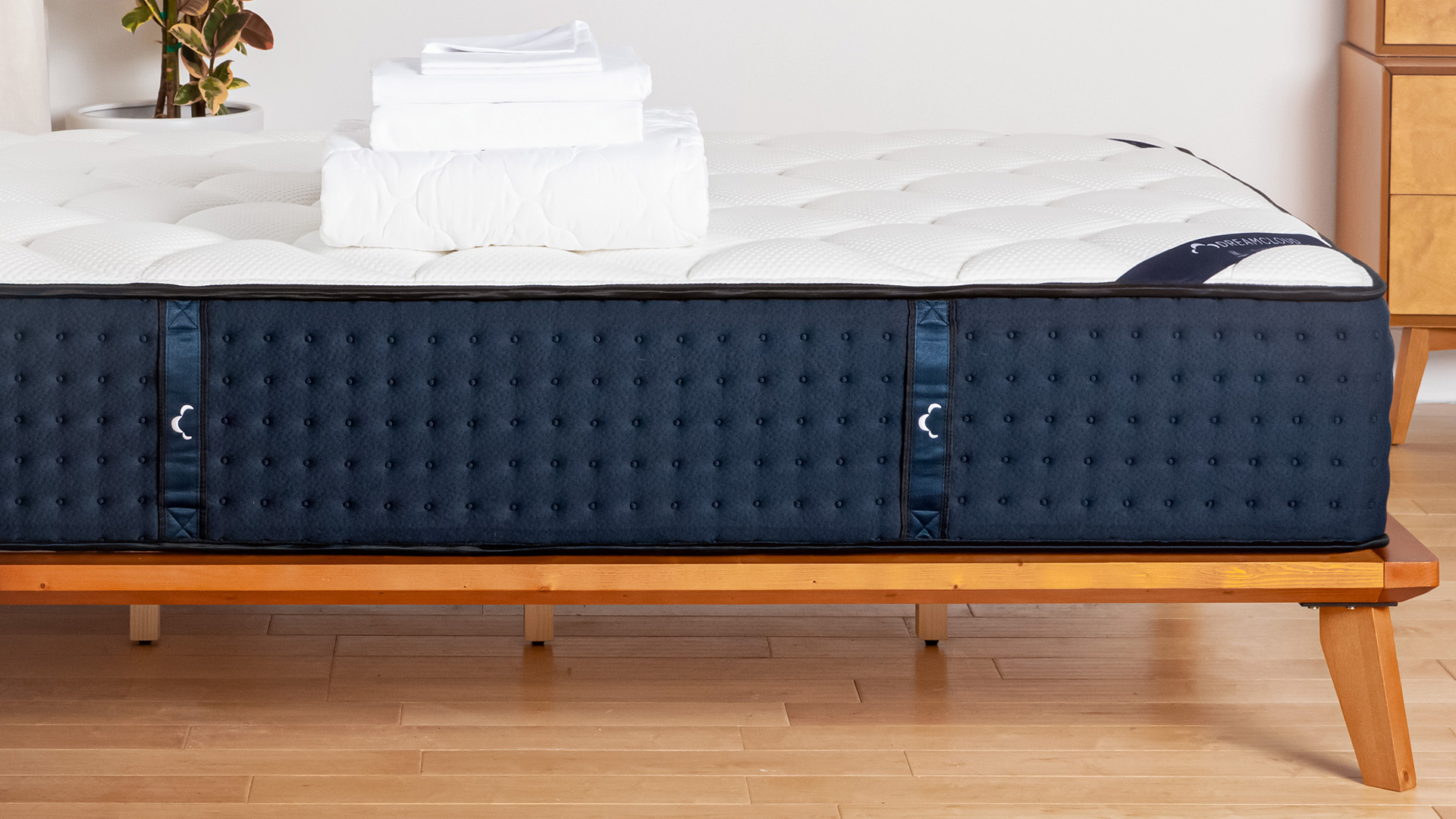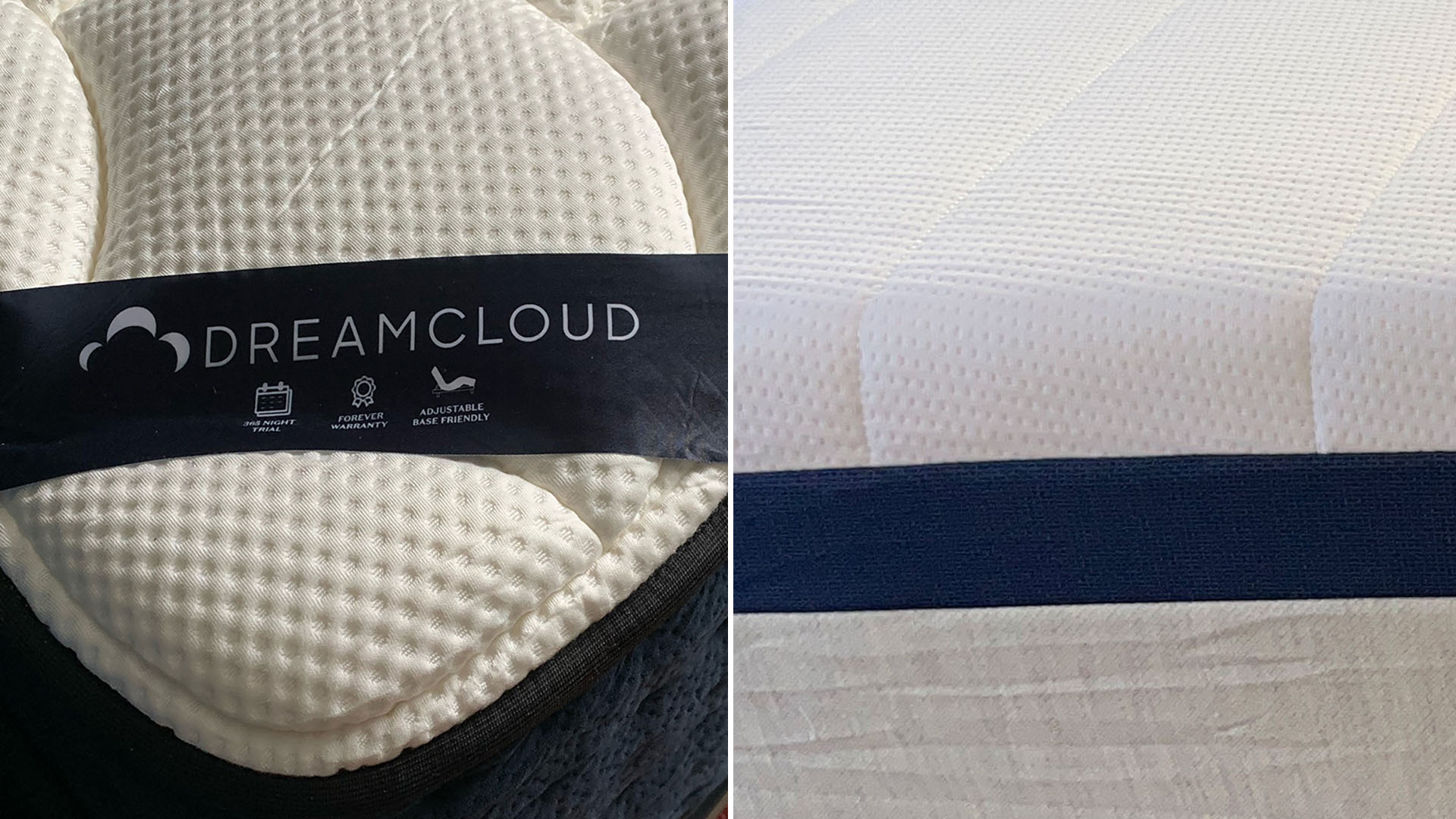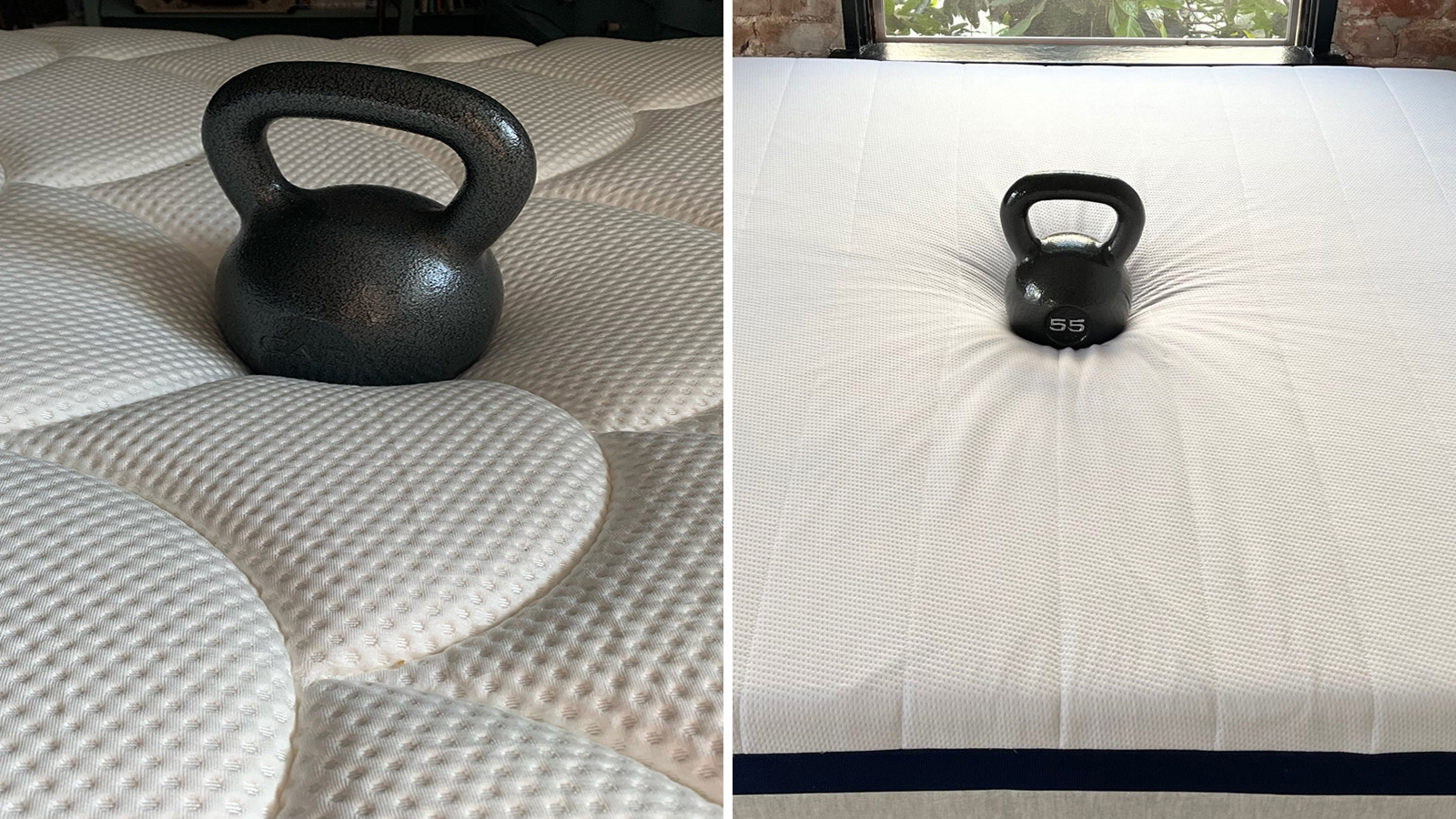[ad_1]
Our best hybrid mattress guide contains some of the most popular (and most comfortable) beds on the market, so if you’re thinking of upgrading your sleep setup, this is an excellent place to start. And occupying the top spots on our list are two incredible beds – the DreamCloud mattress and the Helix Midnight mattress. But which hybrid is right for you?
Here at TechRadar, we’ve had the opportunity to test out both these mattresses – head to our DreamCloud mattress review and our Helix Midnight mattress review for the in-depth results. To cut a long story short, these hybrid mattresses use a combination of springs and foams to deliver exceptional support, and they’re both good enough to earn a place in our overall best mattress guide.
In this article, we’ll break it down and compare exactly how the the DreamCloud vs Helix Midnight match up in a range of specific areas. Overall, we think the DreamCloud mattress is the better hybrid bed, winning three categories and drawing the fourth. An affordable yet high quality bed, the DreamCloud hybrid mattress has a versatile sleep surface that will suit a range of people.
However, this isn’t quite the runaway victory you might expect from those results. The Helix Midnight puts up a good fight, especially as the softer surface makes it one of the very best mattresses for side sleepers as well as those with a lighter build. Preference plays a big role in which mattress to choose, so let’s dive into this DreamCloud vs Helix Midnight showdown and see what’s happening.
DreamCloud vs Helix Midnight mattress: specs
| Header Cell – Column 0 | DreamCloud | Helix Midnight |
|---|---|---|
| Type | Hybrid | Hybrid |
| Materials | Gel memory foam, other foams, pocket coils | Memory foam, polyfoam, pocket coils |
| Cover | Cashmere-blend fabric, not removable | Breathe knit cover (GlacioTex cooling cover available as an upgrade) |
| Handles | Yes | No |
| Firmness (1-10) | Officially 6.5, we rate 7.5 | 5.5 |
| Height | 12 inches | 11.5 inches |
| Trial period | 365 nights | 100 nights |
| Warranty | Lifetime | 10 year |
| Price bracket | Lower mid-range / mid-range | Mid-range |
| Queen price | MSRP $1,332 (usually sold at $799) | MSRP $1,373.80 (usually sold at $1,099) |
| Sizes | Twin, twin XL, full, queen, king, Cal king | Twin, twin XL, full, queen, king, cal king, short queen, RV king |
| Delivery | Free standard delivery, $199 for White Glove | Free standard delivery |
| Returns | Free | Free |
DreamCloud vs Helix Midnight mattress: design
- Both hybrid mattresses containing a combination of springs and foam
- Both feature a variety of foams, including memory foam
- Premium upgrades available for both – more layers and increased cooling
Both the DreamCloud and the Helix Midnight are hybrid beds, meaning they contain springs and foams (you can learn more with our memory foam vs hybrid mattress explainer).
The DreamCloud contains six internal layers, plus a cashmere upper cover and a shift-resistant lower cover. At the top is a layer of quilted gel memory foam, designed to be both contouring and breathable. Beneath this sits a layer of support foam, followed by a layer of adaptive, cushioning, gel-infused memory foam, before a dynamic transition foam. Next comes the springs – individually wrapped coils, with thicker springs placed around the perimeter for support. Finally, there’s one more layer of foam, this time to provide stability at the base.
The Helix Midnight features five internal layers, plus a breathable knit cover (or you can upgrade to the GlacioKnit cooling pillow top cover, for roughly an extra $350). The top layer consists of a Helix-blend memory foam, crafted to provide sleepers with unique pressure relief. Beneath this sits two layers of response foam, offering cushioning alongside ergonomic support. Then there’s the individually wrapped springs – up to 1,000, depending on the mattress size – with reinforced coils at the lengthwise sides. At the base is a layer of DuraDense foam, for stability and durability.
The DreamCloud has the slightly more complex design, and it also comes with handles, which make it easier to move. The Helix Midnight is both handle-less and heavy (a queen weighs 100 lbs, compared to the 78 lbs DreamCloud). If you want to shift the Helix Midnight, you’ll probably need to call in a second pair of hands.

If you like the sound of either mattress but you’d prefer something a little more luxurious, good news: you can opt for a premium upgrade. For the DreamCloud, you can upgrade to the Premier, which is taller with upgraded cooling, or the Premier Rest, which is even taller again and has even better cooling.
But for the biggest choice of upgrades, check out the Helix Midnight. This is available as the the Helix Midnight Luxe, which is taller, comes with a cushioned pillow top cover, and has an additional layer of cooling memory foam. Or there’s the Helix Midnight Elite – it’s more than twice the price, but you’ll get two additional layers of micro-coils, plus a GlacioTex cushioned cover is included as standard. For a more affordable upgrade, add the GlacioTex cooling pillow top cover to the Helix Midnight (you can also add a GlacioTex cover to the Helix Midnight Luxe). There are a lot of ways to customize this bed.
Design winner: DreamCloud
The DreamCloud just takes this thanks to its extra layer and the convenient handles. But it’s a tough call, as they’re both solid designs.
DreamCloud vs Helix Midnight: price & extras
- DreamCloud is lower-mid range with a year trial and lifetime warranty
- Helix Midnight is mid-range with a 100-night trial and 10-year warranty
- Both mattresses are always discounted
DreamCloud is priced at $1,332 for a queen, which puts it in the upper mid-range price bracket. However, you never have to pay full price at DreamCloud. Sales run throughout the year, with a queen typically sold for $799. If you’re lucky, you might be able to grab it during a DreamCloud half price sale, when the queen sells for $665, putting it in the lower-mid range.
Similarly, while the Helix Midnight has an MSRP of $1,373.80, you should never pay full price. The Helix Midnight evergreen sale always knocks off 20%, taking a queen down to $1,099 and you can expect Helix to throw in a freebie as well (typically a pillow set). And like DreamCloud, Helix occasionally offers a bigger discount – you’ll often be able to nab 25% off around the major sale days.
In the evergreen sale, the DreamCloud offers incredible value for the price. It has a luxurious look and feel, and while it might not deliver the longevity and performance of a premium mattress, it goes above and beyond the mid-range price bracket. And although the Helix Midnight isn’t quite so affordable, it’s still great value for money.
When it comes to extras, DreamCloud again over-performs for the price: you get a full 365 nights to test the mattress, plus a forever warranty. The 100-night mattress trial and 10-year warranty of the Helix Midnight can’t compare (although these are fairly standard extras).
Price winner: DreamCloud
DreamCloud vs Helix Midnight: comfort & support
- DreamCloud is a medium-firm bed (7.5/10)
- Helix Midnight is a medium bed (5.5/10)
- DreamCloud is best for back sleepers, Helix Midnight suits side sleepers
DreamCloud describes the hybrid mattress as “luxury firm”, rating it 6.5 out of 10 on the firmness scale (with one being super-soft and 10 being ultra-hard). Our tester disagreed slightly, rating it as medium-firm and placing it at 7.5 on the scale.
This makes the DreamCloud a pretty versatile mattress. Our tester found it comfortable in a range of sleep positions, and rated it highly for alleviating joint and back pains (it’s one of our best mattresses for back pain). The medium-firm feel will probably suit back sleepers best, but it can also work for side and stomach sleepers. However, lightweight side sleepers might need something softer, while stomach sleepers with a heavier build might prefer something firmer. Overall, however, this is a mattress with a wide appeal.

We typically expect hybrid mattresses to be on the firmer side, but the Helix Midnight bucks that trend with a medium feel and a contouring effect. The official rating from Helix spans five and six out of ten, and our tester largely agreed, rating it a 5.5 (or medium).
A softer feel provides more cushioning at the pressure points, which is why we recommend this bed for side sleepers – in fact, the Helix Midnight is among the best mattresses for side sleepers. However, back and stomach sleepers, as well as those with a heavier build, might need to opt for something firmer.
Comfort winner: draw
It really comes down to personal preference here, as the DreamCloud and Helix Midnight suit different sleep styles. Want something firmer? Go for the DreamCloud. Prefer a softer cushioning? Helix Midnight is the winner.
DreamCloud vs Helix Midnight: performance
- Both are breathable mattresses (with cooling upgrades for hot sleepers)
- Both have strong motion isolation
- DreamCloud offers slightly better edge support
We test all our mattresses in three key areas: temperature regulation, motion isolation, and edge support. These attributes help us understand how the mattress performs during the night.
Despite neither mattress being a cooling bed, we were impressed with the temperature regulation of both the DreamCloud and the Helix Midnight. Hybrid mattresses are typically breathable thanks to those open coils, and these beds stay an even temperature throughout the night. Very hot sleepers might want to invest in a cooling upgrade – the premium version of both beds come with increased cooling capabilities – but the average sleeper should be pleasantly comfortable.

Motion isolation refers to how much disruptive movement travels across the bed. Simply put, if one person moves, can the other person in the bed feel it? Both the DreamCloud and Helix Midnight mattress impressed our testers with how well they trapped motion, meaning if you share with a restless partner, you should be able to sleep undisturbed (or, at least, not go barreling towards a sleep divorce).
Finally, edge support. This describes how strong a mattress is at the perimeter. Do the sides collapse when you push against them? Or can you sit on the edge of the mattress and still feel a sturdy support? While both mattresses are rated highly in this category, the DreamCloud just comes out on top. With the Helix Midnight, our tester felt the edges showed a “notable amount of sinkage” when they were reclining at night. This sinkage wasn’t an issue with the DreamCloud.
Winner: DreamCloud
DreamCloud vs Helix Midnight: which should I buy?
Buy the DreamCloud if…
✅ You sleep on your back: The DreamCloud offers good support for a range of sleeping positions, but the medium-firm feel is best suited for back sleepers. it hits the sweet spot between supporting and cushioning, offering impressive pressure relief while keeping your spine aligned.
✅ You push against the edge of the bed to get up: With reinforced coils placed around the perimeter of the mattress, the DreamCloud provides edge-to-edge support. If you push against the side of the bed to get up in the morning, you’ll find a stable base with the DreamCloud.
✅ You’re on a tighter budget: You never have to pay full price for the DreamCloud hybrid, with an evergreen discount making this mattress excellent value for money. Even better, you’ll get a 365-night trial to decide if the bed’s for you, plus peace of mind thanks to a lifetime warranty.
Buy the Helix Midnight if…
✅ You sleep on your side: Softer than your usual hybrid, the Helix Midnight offers comforting pressure relief for side sleepers. Your hips and shoulders will feel cushioned while the spine has ample support, for a dreamy experience.
✅ You want a hybrid without the bounce: Due to that layer of springs, hybrids are known for being bouncier beds than their all-foam counterparts. However, the softer top foam layers of the Helix Midnight give the bed a plusher feel, resulting in a mattress that provides a contouring pressure relief, instead of the responsiveness of a traditional hybrid. Although not quite the ‘hug’ you’d expect from the best memory foam mattresses, the Helix Midnight offers a nice middle ground.
[ad_2]
Source Article Link


